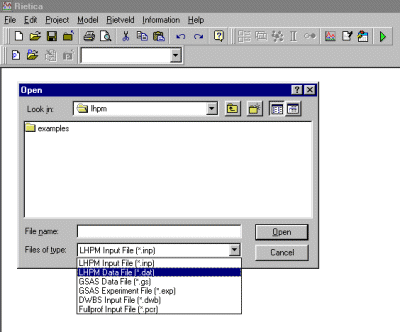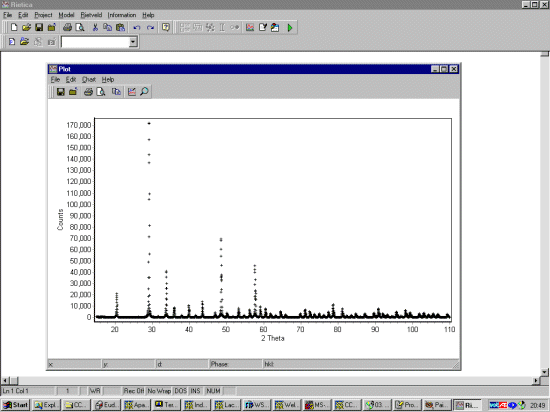

|
Note: The following is just a guide to show you how to start a new
refinement with LHPM-Rietica. It assumes that you know the required
amount of Crystallography and background to Rietveld refinement to be
confident to perform a structure refinement via the Rietveld method.
LHPM-Rietica does come with a manual that gives details on the available options.
|
In the following example, we will go through inputting the
starting information for a new refinement from scratch. The example is
Cubic Y2O3 from the ICSD.
Spacegroup = I A 3 - (206) CELL 10.5981 10.5981 10.5981 90 90 90 Y1 Y 0.25000 0.25000 0.25000 Y2 Y 0.96764 0.00000 0.25000 O1 O 0.39070 0.15180 0.38010 (Note that Rietica-LHPM can import GSAS, Fullprof and DBWS structure files) |
|
If you wish to view the powder diffraction pattern before starting a new Input File,
do File, Open File, and under Files of Type select the drop
list and choose the data file format (usually LHPM Data File (*.dat))
|
|
Start LHPM Rietica and from the file menu go into the start wizard by selecting, File, New Input
|
|
This will bring up the following New input screen.
|
|
Click OK then go into Model, General to set
options such as i) the file format for the data you are using,
ii) number of cycles, iii) damping factors, etc.
|
|
Enter Model, Phases to add the structural information for
Y2O3. If you do not have a Thermal B value, just give a reasonable
value such as 0.6.
Click Right Mouse Button to be given the option of adding an Atom.
|
|
To insert the correct Full occupancy that takes into the site multiplicity, use
Right Mouse Button,
|
|
Enter Model, Histograms to set the wavelength, data range to use,
background, polarisation, and other parameters.
A trick to tell LHPM-Rietica to use the entire range of the data is to set start, step and stop all to 0. If you have single wavelength neutron or X-ray data; put the wavelength in both Wavelength 1 and Wavelength 2 and set the Ratio to zero (0) I prefer a manually defined background though a Shifted Chebyshev can be a good refinable background function to use.
|
|
Enter Model, Sample to set the profile type and profile parameters.
I prefer a Psuedo-Voight (FJC Asym) profile as it is quite flexible for nearly all occassions. I find a good set of "generic" starting parameters to be:
I prefer a manually defined background though a Shifted Chebyshev can be a good refinable background function to use.
|
|
Now save the file using File, Save As. Go into
Rietveld, Refine, select the data file and start performing
the refinement. At minimum, you may like to set some background parameters
to refine (in Model, Histograms) and and scale factor/Phase Scale
(in Model, Phases) to refine.
|